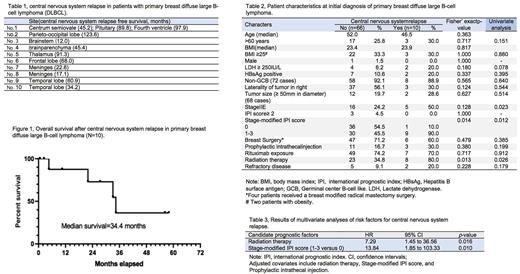Abstract
Objective Primary breast diffuse large B-cell lymphoma (DLBCL) is a rare form of non-Hodgkin lymphoma with a high incidence of central nervous system (CNS) relapse. The prognosis of primary breast DLBCL has been considerably improved, but the development of CNS spread remains a clinical challenge in the treatment of DLBCL. Indeed, the CNS-International Prognostic Index (CNS-IPI) score is considered to be a reproducible tool for identifying patients with a high risk of CNS relapse in patients with DLBCL, not other specified. However, the use of CNS-IPI to predict CNS recurrence is often failed in primary breast DLBCL. There is a paucity of data for identifying high-risk patients for prophylactic therapy based on clinical risk factors in patients with primary breast DLBCL.
Patients and Methods A consecutive cohort of patients with primary breast DLBCL was retrospectively analyzed at Fudan University Shanghai Cancer Center (FUSCC) from February 1997 through July 2018. Overall survival (OS) from CNS relapse was calculated from the diagnosis of CNS relapse to death from any cause using the Kaplan-Meier method. Patient characteristics were analyzed for their association with time to CNS relapse using competing risk regression (CRR) based on Fine and Gray's sub-hazard ratios (HRs) with 95% confidence interval (95% CI) as measures of association. The multivariate analyses were conducted using characteristics which were significant in the univariate analyses.
Results Of the 76 patients with primary breast DLBCL, 10 (13.2%) patients experienced a CNS relapse during the median follow-up of 6.8 years (range: 0.4-25.0 years). Eight patients presented with parenchymal mass of the brain and two with leptomeningeal disease. The median time from initial diagnosis of primary breast DLBCL to CNS relapse was 3.8 years (range: 1.0-10.3 years). Six (60%) patients occurred CNS relapses within the first 5 years (Table 1). The median survival following a CNS relapse in primary breast DLBCL patients was 2.9 years (range: 0.05-4.8 years) (Figure 1).
Patients with CNS relapse had a median age at the time of diagnosis of primary breast DLBCL at 46.5 years of age, with the majority (70.0%) being less than 60 years of age (Table 2). Patients with a high stage-modified IPI score (1-3) were more likely to experience a CNS relapse than those with a low score (0) (p=0.014). In our cohort, all patients with primary breast DLBCL were treated with first-line chemotherapy. Additionally, patients with CNS relapse had a higher proportion of previous radiation therapy (RT) than patients without CNS relapse (p=0.013). However, the proportion of tumor size, prophylactic intrathecal injection, non-GCB subtype, HBsAg status, IPI score, or refractory disease was comparable between the two groups.
In univariate analysis (Table 2), the significant risk factors of CNS relapse by the CRR model were stage IIE (p=0.023), stage-modified IPI score (p=0.016), and RT (p=0.026). However, there was no difference in the incidence of CNS relapses between treatment with or without rituximab, breast surgery, or CNS prophylactic chemotherapy. In multivariate analysis (Table 3), both the stage-modified IPI score (hazard ratio: 13.84, 95%CI 1.85-103.33, p=0.010) and RT (hazard ratio: 7.29, 95%CI 1.45-36.56, p=0.016) were found to be statistically significant for predicting CNS relapse among patients with primary breast DLBCL.
Conclusion Our data implied that the high stage-modified IPI score and needed additional RT were identified as the high risk of CNS relapse population.
Disclosures
No relevant conflicts of interest to declare.
Author notes
Asterisk with author names denotes non-ASH members.


This feature is available to Subscribers Only
Sign In or Create an Account Close Modal